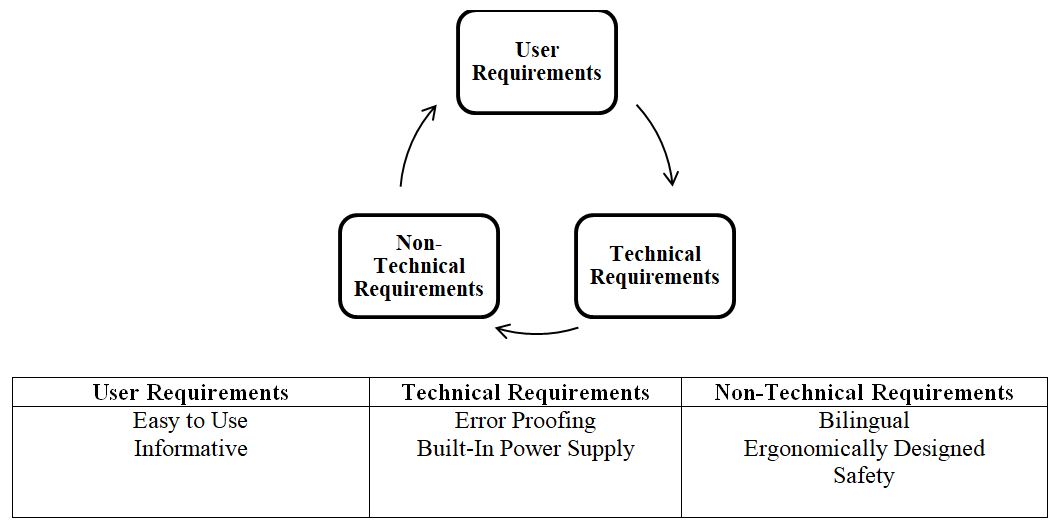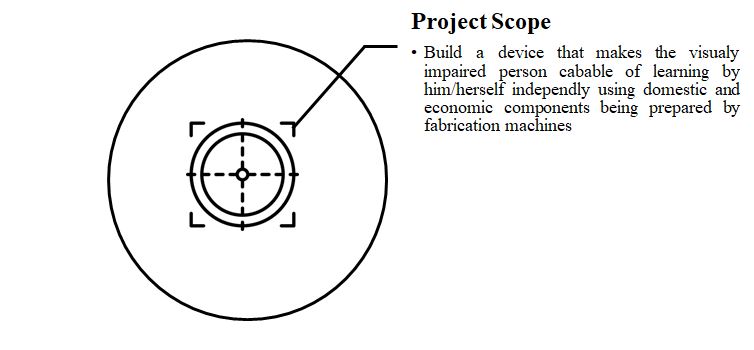Project Scope

Plan the Scope
In this phase I have done a market research about the problem to be identified and defined, dig deeper in the real pain, and define abstractly how the final project would be a blueprint towards killing this pain. Answering the questions below regarding the problem would give a broader explanation.
Problem Statement
Visually impaired people could not learn independently.
Collect Requirements
Regarding the problem identified,
the different requirements has been gathered under different categories:

Define the Scope
In this phase a scope of the project is defined in a statement and the scope detailed definitions such as the product specifications are listed in the answers to the questions below.

Control the Scope
This is a running phase which is activated throughout the whole implementation process of the project to make sure of four main things.
- Solving the identified problem
- Sticking to the scope
- Sticking to the requirements
- Utilize the available resources
Questions to be Answered
Regarding the identified problem and projects scope, this is a questions list that has to be answered to have a clear insight about the implications, applications, and implementation of the project.
What will it do?
The project will be a teaching puzzle for visually impaired people who wants to learn about different contents in their own. It will be an electronically designed puzzle that allows the learner to pick the continent part, put it in its dedicated place it in the puzzle board, and then automatically the board will start speaking the continent name.
Who has done what beforehand?
There is a startup called Seraj in our lab are working in producing a puzzle to help people in general learning about the geometrical shapes. The difference here is that the Seraj project is a manual board that needs a facilitator or a helper to facilitate the learner. Furthermore, there is lots of such projects in the toys market that speak the puzzle piece name, but it is for geometrical shapes, numbers or zoo stuff and nothing has been done before for continent and such a content.
What will you design?
| Component Name |
Function |
Design Concept |
Implementation Tools |
| Puzzle Parts |
Continents parts |
Drafts |
Molding and casting |
| Puzzle Board |
Casing of the puzzle parts |
2D- Design |
Laser Cutting |
| Controlling system |
The board that includes the micro-controller,
the brain of the project |
Electronics, PCB Design |
Modella, Soldering |
What materials and components will be used?
Puzzle: Puzzle block from casting, puzzle board/casing
Electronics: Sensors, speakers, microcontrollers, buttons/switches, cupper boards
Where will they come from?
Buy: raw materials for casting and puzzle casing, sensors, electronics basic components such as switches and jumpers, speakers (From the Lab Inventory)
Make: Casting and finally used puzzle parts and casing, PCB (Using Lab M/Cs).
How much will they cost?
Not determined yet.
What parts and systems will be made?
- Casting and finally used puzzle parts
- Casing
- PCB (Using Lab M/Cs)
- Programming by ISP
What processes will be used?
Approach Used: Design Thinking.
Technical Processes: Casting, Molding, Milling, Laser Cutting.
What questions need to be answered?
To accomplish the final project there are lots of things have to be done
- Empathy with the visually impaired people (Empathy list of questions)
- How can I do programming with ISP?
- How can I do milling for 3D-shapes?
- What is the well-functioning and cost-efficient components?
How will it be evaluated?
The evaluation will be made through the implementation process in two main levels:
The first level is that related to the scope defined it will be made by the project owner (me) to make sure if the project goals and objectives have been accomplished.
the second level is the user feedback that allow me to make sure that the user is getting the best benefit out of the project and has felt a difference in learning independently.
Preliminary Implementation Plan
- Preparation of the Puzzle Parts:
- Prepare mold material (Silicon)
- Make the mold
- Pour the puzzle parts material (epoxy)
- Wait to cool
- Extract
- Preparation of the Puzzle Board:
- 2D design to be laser catted
- Laser cut the board
- Electronics
- Do PCB design
- Mill it using Modella
- Assembly of the electronic components including speakers and sensors
- Programming:
- Program the controller
And finally the product is ready to be tested...
Done
- Searching.
- Brainstorming and analyize my project.
New Learned
- How to categorize every detail in my project.
- How to get out with the bill of materials.
